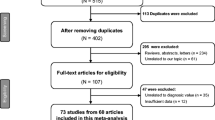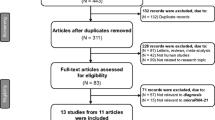Abstract
The low survival rates of cancers are primarily due to late diagnosis and metastasis. Discriminating the metastasis is a crucial factor for prognosis and improving the survival rate of cancer patients. MicroRNAs (miRNAs) can regulate the expression of hundreds of downstream genes, which has a broad effect on the regulation of the whole cell cycle. Accumulating studies have found that the aberrant expression of miRNAs is associated with cancer genesis. The aim of this study is to evaluate the diagnostic value of miRNAs in detecting cancer metastasis. Medline, PubMed, Embase, and CNKI were searched for relevant articles. Sensitivity, specificity, positive and negative likelihood ratio (PLR, NLR) and diagnostic odds ratio (DOR), the summary receiver operator characteristic (SROC) curve and the calculated AUC (area under the SROC curve) were applied to explore the diagnostic accuracy of miRNAs in metastasis. Seven hundred seventy-one metastatic cancer patients and 552 non-metastatic cancer controls from 14 articles were involved in our meta-analysis. A sensitivity of 0.75 (95 % confidence interval (CI), 0.72–0.79) and a specificity of 0.80 (95 % CI, 0.76–0.84) were observed from metastatic patients and non-metastatic controls in the combined analysis. And the AUC was 0.83 (95 % CI, 0.79–0.86). In addition, results from subgroup analyses suggested that a higher diagnostic value for metastasis was acquired in tissue sample other than blood sample (sensitivity, 0.82 versus 0.73; specificity, 0.84 versus 0.79; PLR, 5.0 versus 3.5; NLR, 0.22 versus 0.34; DOR, 23 versus 10; AUC, 0.88 versus 0.80). In summary, this meta-analysis proved the relatively high diagnostic value of miRNA in metastasis, which might be applied as a novel screening tool to detect metastasis along with other biomarkers. We also illustrated that tissue-based miRNAs may have a better diagnostic accuracy than blood-based miRNAs.





Similar content being viewed by others
References
DeSantis CE, Lin CC, Mariotto AB, Siegel RL, Stein KD, Kramer JL, et al. Cancer treatment and survivorship statistics, 2014. CA Cancer J Clin. 2014;64:252–71.
Wang Q, Wu X, Wu T, Li GM, Shi Y. Clinical significance of RKIP mRNA expression in non-small cell lung cancer. Tumour Biol. 2014;35:4377–80.
El-Serag HB, Rudolph KL. Hepatocellular carcinoma: epidemiology and molecular carcinogenesis. Gastroenterology. 2007;132:2557–76.
Song MY, Pan KF, Su HJ, Zhang L, Ma JL, Li JY, et al. Identification of serum microRNAs as novel non-invasive biomarkers for early detection of gastric cancer. PLoS One. 2012;7:14.
Sturgeon CM, Duffy MJ, Hofmann BR, Lamerz R, Fritsche HA, Gaarenstroom K, et al. National academy of clinical biochemistry laboratory medicine practice guidelines for use of tumor markers in liver, bladder, cervical, and gastric cancers. Clin Chem. 2010;56:5.
Metindir J, Bilir DG. Evaluation of prognostic significance in extracapsular spread of pelvic lymph node metastasis in patients with cervical cancer. Eur J Gynaecol Oncol. 2008;29:476–8.
Biewenga P, van der Velden J, Mol BW, Stalpers LJ, Schilthuis MS, van der Steeg JW, et al. Prognostic model for survival in patients with early stage cervical cancer. Cancer. 2011;117:768–76.
Lowery AJ, Walsh S, McDermott EW, Prichard RS. Molecular and therapeutic advances in the diagnosis and management of malignant pheochromocytomas and paragangliomas. Oncologist. 2013;18:391–407.
Chen J, Yao D, Li Y, Chen H, He C, Ding N, et al. Serum microRNA expression levels can predict lymph node metastasis in patients with early-stage cervical squamous cell carcinoma. Int J Mol Med. 2013;32:557–67. doi:10.3892/ijmm.2013.1424.
Chen JY, Yao DS, He CJ, Lu Y. [Relationship between serum miR-21 and lymph node metastasis in cervical cancer]. J Xi’an Jiaotong Univ (Med Sci). 2012;33:351–5.
Chen Q, Ge X, Zhang Y, Xia H, Yuan D, Tang Q, et al. Plasma miR-122 and miR-192 as potential novel biomarkers for the early detection of distant metastasis of gastric cancer. Oncol Rep. 2014;31:1863–70. doi:10.3892/or.2014.3004.
Chen W, Cai F, Zhang B, Barekati Z, Zhong XY. The level of circulating miRNA-10b and miRNA-373 in detecting lymph node metastasis of breast cancer: potential biomarkers. Tumour Biol. 2013;34:455–62. doi:10.1007/s13277-012-0570-5.
Chen YX, Ma CL, Chen ZF, Zhang W. Clinical significance of miR-143 expression in women with cervical cancer of Uyghur and Han ethnicities, in Xinjiang. Zhonghua Liu Xing Bing Xue Za Zhi. 2013;34:1120–4.
Feng L, Pang Z, Sha S, Wu B, Xu F, Yin SP. The value of diagnosis and prognosis prediction of serum mi-29a for colorectal cancer. Chin J Clin Oncol Rehabil. 2013;20:1313–5.
Huang L, Lin JX, Yu YH, Zhang MY, Wang HY, Zheng M. Downregulation of six microRNAs is associated with advanced stage, lymph node metastasis and poor prognosis in small cell carcinoma of the cervix. PLoS One. 2012;7:e33762. doi:10.1371/journal.pone.0033762.
Kim SY, Jeon TY, Choi CI, Kim DH, Kim GH, Ryu DY, et al. Validation of circulating miRNA biomarkers for predicting lymph node metastasis in gastric cancer. J Mol Diagn. 2013;15:661–9. doi:10.1016/j.jmoldx.2013.04.004.
Lu J, Xu X, Liu X, Peng Y, Zhang B, Wang L, et al. Predictive value of miR-9 as a potential biomarker for nasopharyngeal carcinoma metastasis. Br J Cancer. 2014;110:392–8. doi:10.1038/bjc.2013.751.
Wang LG, Gu J. Serum microRNA-29a is a promising novel marker for early detection of colorectal liver metastasis. Cancer Epidemiol. 2012;36:e61–7. doi:10.1016/j.canep.2011.05.002.
Wu WY, Xue XY, Chen ZJ, Han SL, Huang YP, Zhang LF, et al. Potentially predictive microRNAs of gastric cancer with metastasis to lymph node. World J Gastroenterol. 2011;17:3645–51. doi:10.3748/wjg.v17.i31.3645.
Yin J, Bai Z, Song J, Yang Y, Wang J, Han W, et al. Differential expression of serum miR-126, miR-141 and miR-21 as novel biomarkers for early detection of liver metastasis in colorectal cancer. Chin J Cancer Res. 2014;26:95–103. doi:10.3978/j.issn. 1000-9604.2014.02.07.
Zhao FL, Hu GD, Wang XF, Zhang XH, Zhang YK, Yu ZS. Serum overexpression of microRNA-10b in patients with bone metastatic primary breast cancer. J Int Med Res. 2012;40:859–66.
Zhao S, Yao D, Chen J, Ding N. Circulating miRNA-20a and miRNA-203 for screening lymph node metastasis in early stage cervical cancer. Genet Test Mol Biomark. 2013;17:631–6. doi:10.1089/gtmb.2013.0085.
Leber MF, Efferth T. Molecular principles of cancer invasion and metastasis (review). Int J Oncol. 2009;34:881–95.
Xu X, Yang X, Ru G, Wu Y, Zhang S, Xing C, et al. miR-146a gene polymorphism rs2910164 and the risk of digestive tumors: a meta-analysis of 21 case-control studies. Oncol Rep. 2014;31:472–9. doi:10.3892/or.2013.2854.
Wan D, Gu W, Xu G, Shen C, Ding D, Shen S, et al. Effects of common polymorphisms rs2910164 in miR-146a and rs11614913 in miR-196a2 on susceptibility to colorectal cancer: a systematic review meta-analysis. Clin Transl Oncol. 2014. doi:10.1007/s12094-013-1150-x.
Li YJ, Zhang ZY, Mao YY, Jin MJ, Jing FY, Ye ZH, et al. A genetic variant in MiR-146a modifies digestive system cancer risk: a meta-analysis. Asian Pac J Cancer Prev. 2014;15:145–50.
Hua HB, Yan TT, Sun QM. miRNA polymorphisms and risk of gastric cancer in Asian population. World J Gastroenterol. 2014;20:5700–7. doi:10.3748/wjg.v20.i19.5700.
Hu Y, Yu CY, Wang JL, Guan J, Chen HY, Fang JY. MicroRNA sequence polymorphisms and the risk of different types of cancer. Sci Rep. 2014;4:3648. doi:10.1038/srep03648.
Takeshita F, Patrawala L, Osaki M, Takahashi RU, Yamamoto Y, Kosaka N, et al. Systemic delivery of synthetic microRNA-16 inhibits the growth of metastatic prostate tumors via downregulation of multiple cell-cycle genes. Mol Ther. 2010;18:181–7.
Rahim F, Hajizamani S, Mortaz E, Ahmadzadeh A, Shahjahani M, Shahrabi S, et al. Molecular regulation of bone marrow metastasis in prostate and breast cancer. Bone Marrow Res. 2014;405920:23.
Tavazoie SF, Alarcon C, Oskarsson T, Padua D, Wang Q, Bos PD, et al. Endogenous human microRNAs that suppress breast cancer metastasis. Nature. 2008;451:147–52.
Peng X, Guo W, Liu T, Wang X, Tu X, Xiong D, et al. Identification of miRs-143 and −145 that is associated with bone metastasis of prostate cancer and involved in the regulation of EMT. PLoS One. 2011;6:27.
Huang S, Guo W, Tang Y, Ren D, Zou X, Peng X. miR-143 and miR-145 inhibit stem cell characteristics of PC-3 prostate cancer cells. Oncol Rep. 2012;28:1831–7.
Zhang HL, Qin XJ, Cao DL, Zhu Y, Yao XD, Zhang SL, et al. An elevated serum miR-141 level in patients with bone-metastatic prostate cancer is correlated with more bone lesions. Asian J Androl. 2013;15:231–5.
Huang Q, Gumireddy K, Schrier M, le Sage C, Nagel R, Nair S, et al. The microRNAs miR-373 and miR-520c promote tumour invasion and metastasis. Nat Cell Biol. 2008;10:202–10.
Conflicts of interest
None
Author information
Authors and Affiliations
Corresponding author
Electronic supplementary material
Below is the link to the electronic supplementary material.
Supplements S1
PRISMA Checklist. (DOC 64 kb)
Rights and permissions
About this article
Cite this article
Han, C., Yu, H., Zhang, L. et al. MicroRNAs used as novel biomarkers for detecting cancer metastasis. Tumor Biol. 36, 1755–1762 (2015). https://doi.org/10.1007/s13277-014-2777-0
Received:
Accepted:
Published:
Issue Date:
DOI: https://doi.org/10.1007/s13277-014-2777-0




